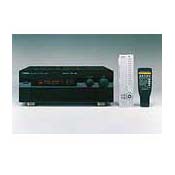Yamaha RX-V2095 A/V Receivers
Yamaha RX-V2095 A/V Receivers
|
[Mar 20, 2000]
Zack
Audio Enthusiast
Strength:
I sure it's nice.
Weakness:
Haven't tested it yet... Just wanted to comment on all the hooplah happenin, I enjoyed a good hours worth of laughs thanks to Mr. Teddy or Buzz or whatever his name is. I do agree with GDL that if you are going to take the time to post a review then you should also take the time to qualify your statments with some accurate information. Emotional or opinionated statments really don't belong. I use this web site to help me decide which products to buy. I like to know why other people either like it or hate it, not just that they do. Just to qualify myself a little I'll let you know that I'm still running a Sony STR-DE915. Please don't laugh. I have had nothing but problems with it, The coaxial AC3 doesn't work. The sound is very flat and it takes all that the amp has to power my little Paradigm Monitor 7's during a movie and gets hot enough to cook eggs on which I worry about since almost every review about the deck says that they burn out because of heat related problems. That's why I'm here, i'm lookin for a new deck. Anyways, If you really don't like the sound then tell us why. If you think it's great then tell us that too! That is what this portion of the site is here for after all, right? Similar Products Used: Sony, Denon, Harman Kardon, Marantz, Kenwood, Pioneer |
|
[Mar 19, 2000]
MICHAEL
Audio Enthusiast
Strength:
POWER LINKED HIGH QUALITY SOUND AND CONSTRUCTION.
Weakness:
NONE DETERMINED AS OF YET. THIS A/V RECIEVER IN MY OPINION IS AT THE TOP OF THE LIST;IT PRODUCES CLEAN/ACCURATE SOUND AT ANY LEVEL,AND I OBSERVED VERY HIGH QUALITY CONSTRUCTION OF THIS OUTSTANDING RECIEVER WHICH IN THESE DAYS IS SO HARD TO FIND,ALSO ITS LARGER THAN OTHERS SO TAKE THIS INTO CONSIDERATION WHEN BUYING A STAND OR WALL UNIT. Similar Products Used: DENON |
|
[Mar 29, 1999]
Danny
an Audio Enthusiast
After reading this "Product Review" i purchased the old and good 3090 instead of 2095 !!I prefer the DSP's rather the RXV's . |
|
[Mar 29, 1999]
cl
Hmm, some people are old fashioned. Again, the 3090 is an amplifier not a receiver. It is a pity that one could not distinguish the two. And giving a whole lot of specifications without actually listening is irrelent. |
|
[Mar 29, 1999]
cl
an Audiophile
This is a followup to my previous review.Some people apparently thinks this receiver has no ac3 demodulator. |
|
[Mar 29, 1999]
ac3-dude
an Audio Enthusiast
just to let you know the ac3 demodulator is for use with laserdisc not dvd.next time please try to get the facts straight. |
|
[Mar 29, 1999]
cl
l admit l am a fool and careless dude. l have omitted the word LD. |
|
[Mar 29, 1999]
Bran
an Audiophile
Hey, cl, The 2095 can not play a LD in DD without it. By the way, I dont care for the amps in my 2095. Way to bright. Thats why I got the ATI 1505. Much more dynamic. Night & Day. The 2095 is a much better "pre-amp". |
|
[Mar 30, 1999]
Singapore Forever
an Audiophile
Oh ya, this is cl back from the Grave. l have one more last word before l leave this audioreview forver. |
|
[Mar 30, 1999]
TOM
an Audio Enthusiast
Some people must understand that RF input in 2095 is only for LD not DVD. |



